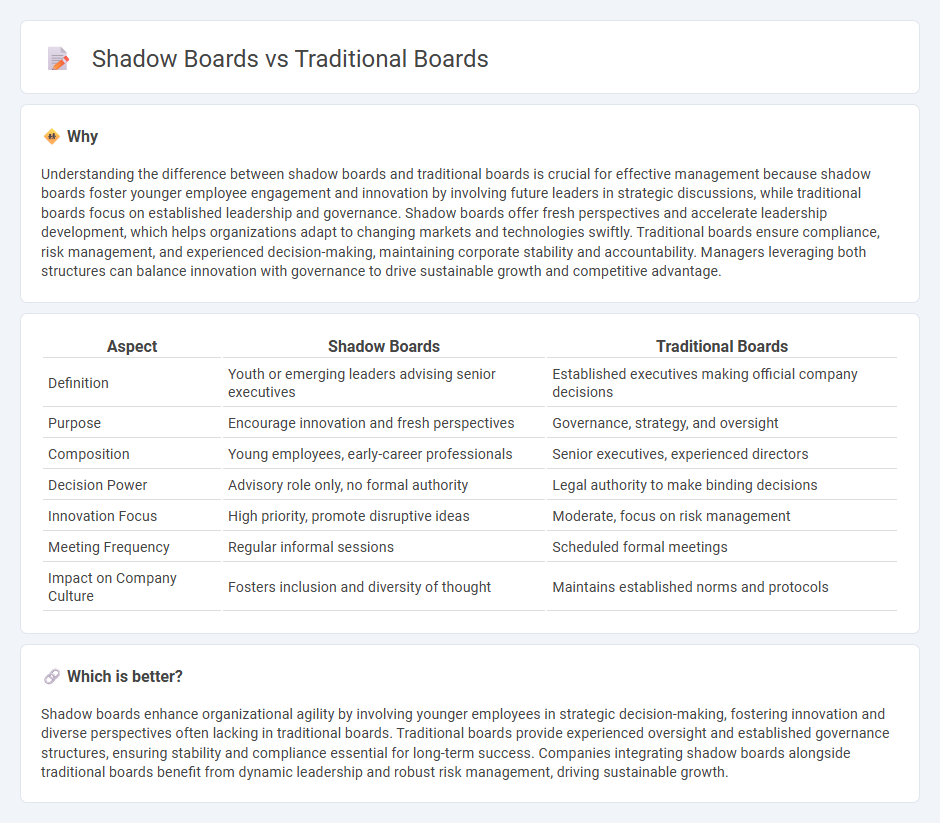
Shadow boards consist of younger or less experienced employees who provide fresh perspectives and innovative ideas that complement the strategic decisions made by traditional boards composed of senior executives. These boards enhance corporate governance by fostering diversity, encouraging employee engagement, and supporting agile decision-making processes in dynamic markets. Explore how integrating shadow boards can transform leadership effectiveness and drive organizational growth.
Why it is important
Understanding the difference between shadow boards and traditional boards is crucial for effective management because shadow boards foster younger employee engagement and innovation by involving future leaders in strategic discussions, while traditional boards focus on established leadership and governance. Shadow boards offer fresh perspectives and accelerate leadership development, which helps organizations adapt to changing markets and technologies swiftly. Traditional boards ensure compliance, risk management, and experienced decision-making, maintaining corporate stability and accountability. Managers leveraging both structures can balance innovation with governance to drive sustainable growth and competitive advantage.
Comparison Table
| Aspect | Shadow Boards | Traditional Boards |
|---|---|---|
| Definition | Youth or emerging leaders advising senior executives | Established executives making official company decisions |
| Purpose | Encourage innovation and fresh perspectives | Governance, strategy, and oversight |
| Composition | Young employees, early-career professionals | Senior executives, experienced directors |
| Decision Power | Advisory role only, no formal authority | Legal authority to make binding decisions |
| Innovation Focus | High priority, promote disruptive ideas | Moderate, focus on risk management |
| Meeting Frequency | Regular informal sessions | Scheduled formal meetings |
| Impact on Company Culture | Fosters inclusion and diversity of thought | Maintains established norms and protocols |
Which is better?
Shadow boards enhance organizational agility by involving younger employees in strategic decision-making, fostering innovation and diverse perspectives often lacking in traditional boards. Traditional boards provide experienced oversight and established governance structures, ensuring stability and compliance essential for long-term success. Companies integrating shadow boards alongside traditional boards benefit from dynamic leadership and robust risk management, driving sustainable growth.
Connection
Shadow boards and traditional boards are connected through their complementary roles in corporate governance, where shadow boards provide fresh, innovative perspectives from younger or emerging leaders, enriching the strategic decision-making of traditional boards. Shadow boards act as advisory groups that challenge conventional thinking and bring new insights, which help traditional boards navigate evolving market dynamics and foster a culture of inclusivity. This synergy enhances overall management effectiveness by integrating diverse viewpoints into governance processes.
Key Terms
Decision-making
Traditional boards often rely on hierarchical decision-making processes, where authority is concentrated among a few key members, potentially slowing down responsiveness and innovation. Shadow boards, composed typically of younger or diverse perspectives, provide fresh insights and facilitate more agile decision-making by directly advising the main board on emerging trends and challenges. Discover how integrating shadow boards can enhance strategic decisions and drive organizational growth.
Innovation
Traditional boards often follow hierarchical decision-making processes that can slow innovation, whereas shadow boards consist of younger, diverse employees who provide fresh perspectives and challenge conventional thinking. Shadow boards act as innovation incubators by rapidly testing new ideas and aligning with emerging trends, fostering a culture of agility and creative problem-solving. Explore the benefits of shadow boards to drive groundbreaking innovation in your organization.
Generational diversity
Traditional boards often lack generational diversity, typically composed of senior executives with similar experiences, which can limit innovative perspectives. Shadow boards, incorporating younger employees, enhance generational diversity by bringing fresh insights and fostering a culture of inclusivity and innovation. Discover how integrating shadow boards can transform decision-making and drive dynamic growth in your organization.
Source and External Links
Treeboard's Exclusive Cutting Board Collection - Features hand-shaped cutting boards made from hard maple and white oak, highlighting natural grain without glue or petroleum products.
Classic Cutting Boards by East Bay - Offers traditional solid maple cutting boards carved and assembled in the USA, emphasizing local sourcing.
Traditional Cork Bulletin Boards - Made from self-healing natural cork, these boards are reliable and resistant to flaking over time.
 dowidth.com
dowidth.com